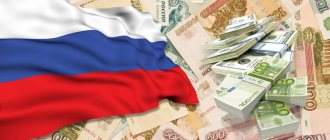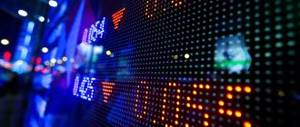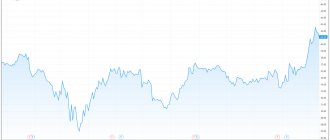| Trader at the New York Stock Exchange. February 5, 2021. NY. Photo: Global Look Press/ZUMA Press |
The US stock market unexpectedly experienced its worst crash since 2011. The markets of Europe and Asia are falling next. Analysts answer whether the fall could mean the beginning of a new crisis and how this situation could affect the ruble.
The key US indices Dow Jones Industrial Average and Standard & Poor's 500 fell sharply on Monday and completely erased their rise since the beginning of the year. The collapse of the Dow Jones in absolute terms (to 25,435 points, by 1.6 thousand during trading) became the maximum in its entire history (in percentage terms, the index lost 4.27%). The Standard & Poor's 500 fell 4.1% to 2,648.94 points. Analysts cite general overbought conditions in American markets as the main reason for the market decline. They grew almost continuously for 15 months in a row, since the election of Donald Trump as President of the United States: investors expected positive results from tax reforms and won back the good reporting of American corporations. Sooner or later, growth was bound to come to a screeching halt, driven by rising inflation expectations: Investors fear that as economic growth picks up, price increases could accelerate significantly, forcing the Federal Reserve to raise rates faster than planned, making money for businesses more expensive in the USA. Having collapsed, the US market pulled the European and Asian ones with it. The Stoxx Europe 600 (a composite index of Europe's largest companies) fell 2.8%, the largest decline since June 2021. The Japanese Nikkei 225 index fell by 4.7%, the fastest pace since November 2016, while the Chinese Shanghai Composite lost 3.4%.
Will the dollar continue to fall and how can you earn income from it?
Why Sberbank?
The fall of Sberbank at a rate higher than the market is largely due to the fact that non-resident investors actively invested in the bank’s shares, say experts interviewed by RBC. “Sberbank is the favorite security of investors in the Russian market, non-residents actively bought it, the share of this security in their portfolios was maximum,” notes invest analyst Mikhail Ganelin. Sberbank has been growing steadily over the past 2.5 years, the analyst recalls, so now, due to the uncertainty of further sanctions and the revaluation of Russian assets in general, investors prefer to take profits.
Sberbank estimated its risks from sanctions at more than 0.5 trillion rubles. Finance
The collapse of Sberbank shares may be due to the fact that the bank is a major creditor of UC Rusal. The fall in quotations of companies that were not subject to sanctions may be due to the fact that market players are reacting to the very possibility of sanctions extending to these companies too, Alfa Capital management analyst Daria Zhelannova tells RBC. “The market is trying to figure out who might be next,” she says.
“According to the imposed sanctions, affiliated companies, obviously associated with sanctioned companies, may be subject to restrictions. For this reason, today, for example, Sberbank securities showed a strong fall. Investors have a feeling that many more companies will fall under sanctions, and they are selling Sberbank not because Sberbank is bad, but because it is associated with “toxic” companies,” explains Bit-Avragim. Further dynamics will depend on whether new sanctions restrictions will be introduced or everything will remain as it is now, the expert concludes.
Best brokers
To work on the US stock market, I first recommend paying attention to the following brokers:
Verified foreign brokers
| Name | Rating | pros | Minuses |
| Interactive Brokers | 8/10 | They speak Russian | Subscription fee 10$ per month |
| CapTrader | 8/10 | No monthly fee | They only speak English |
| Lightspeed | 7/10 | Low minimum deposit | Imposing services |
| TD Ameritrade | 6.5/10 | Low commissions | Not everyone gets an account |
Ruble under pressure
Against the backdrop of a falling stock market, the ruble noticeably weakened its position against the dollar and euro. During trading on April 9, the euro exchange rate to the Russian currency exceeded 75 rubles for the first time since August 2021, and the dollar rose above 60 rubles. By the close of trading, the ruble to euro exchange rate at the auction fell by 2.88 rubles, to 74.26 rubles. per euro, and against the dollar - by 2.12 rubles, up to 60.3 rubles. for a dollar. The official exchange rate set by the Central Bank on April 10: 71.88 rubles. per euro (+1.17), 58.57 rub. per dollar (+0.74).
A reduction in the influx of dollar liquidity due to a reduction in UC Rusal's export revenue may help strengthen the dollar against the ruble, Raiffeisenbank analysts note. According to their calculations, if Russia is unable to export aluminum and receive dollars for it, then the fair exchange rate of the ruble, all other things being equal, will increase by 1.5–2 rubles.
“Finally included”: persons involved and officials on the US sanctions list Photo gallery
At the same time, the expansion of sanctions against Russia is not the only negative factor for the ruble. “The foreign exchange market was already under pressure from stock markets, which were reacting negatively to the escalation of the trade war between China and the United States,” says Yaroslav Lisovolik, chief economist at the Eurasian Development Bank. He believes that oil prices can soften the pressure on the ruble - if they are kept close to the current level (about $68 per barrel - RBC), this will be able to mitigate the effects associated with capital outflow.
The market sees almost no opportunities for the rapid strengthening of the ruble, Ivan Kopeikin, an expert at the BCS financial group, is sure. All the latest news is not playing into the hands of the Russian currency - the purchase of foreign currency by the Ministry of Finance, the increase in the US Federal Reserve rate and the reduction in rates of the Central Bank. Along with rising oil prices, positive political news can strengthen the ruble, the analyst says. At the same time, if there is no additional political pressure, we should not expect any strong weakening of the ruble, he believes.
“It’s hard to say how long this will last. After such a significant weakening of the ruble and with rising oil prices, Russian assets become interesting from an economic point of view. However, it is difficult to say when greed will overcome fear and the opposite dynamics will come to the market,” says Kopeikin.
“The players are waiting for the [Russian authorities] to announce retaliatory measures. If they are directed against American business, then a second wave of weakening of the ruble may follow,” notes Georgy Vashchenko, head of the department of trading operations on the Russian stock market of Freedom Finance Investment Company. Until the end of the week, the ruble will trade in the range of 59–62 rubles. per dollar and 72.55–76.40 rubles. per euro, the expert believes.
Russian stock market crashes
The largest drop in the Russian stock market in recent years occurred in 2008 against the backdrop of the global financial crisis. Then stock indices, which showed historical maximum values in May, declined in the second half of the year, and accelerated their decline in the fall. While the MICEX index fell threefold in May-October, the RTS index fell fourfold. A record drop was recorded on October 6, 2008 - then the RTS index fell by 19.01%, and in January 2009 it fell below 500 points.
Another major collapse occurred in 2014 amid falling world oil prices. The record low value of the RTS index for this year (578.21) was recorded on “Black Tuesday” on December 16 - on this day, after the Bank of Russia raised the key rate from 10.5 to 17%, the rate for bank brokers almost tripled, and some financial institutions have stopped lending to their partners altogether. The fall of the RTS index on December 16 was 12.4%. The trading volume on the Russian stock market in December 2014 decreased by almost half compared to the previous month. At the same time, the Russian stock market showed negative dynamics even before “Black Tuesday”: from January to mid-December 2014, the RTS dollar index showed the worst result in the world with a drop of more than 50%.
History[edit | edit code]
The idea of creating an exchange was formalized on May 17, 1792, when 24 New York brokers, working with financial instruments and concluding transactions, like their London colleagues, in coffee houses (one of them was the Tontine Coffee House), signed the “Agreement under the Sycamore Tree.” (English Buttonwood Agreement) on the creation of the New York Stock Exchange. The shares of The Bank of New York were the first to be listed on the stock exchange in 1792[3].
At the end of the 19th - beginning of the 20th century, the New York Stock Exchange was considered one of the largest exchanges in the world[4].
Since 1975, it has become a non-profit corporation owned by 1,366 individual members (a number that has remained unchanged since 1953).[5] Member seats can be sold, with the cost of one seat currently reaching up to US$3 million.
In early March 2006, the NYSE completed its merger with electronic exchange Archipelago Holdings and offered shares to investors for the first time in its history, thus becoming a commercial entity.
NYSE Group shares are traded on the exchange itself; capitalization as of December 5, 2007 was $22.6 billion.
In early June 2006, it was announced that the New York Stock Exchange would merge with the European stock exchange Euronext. As a result of this merger, which took place on April 4, 2007[6], NYSE Euronext was formed.
In November 2013, IntercontinentalExchange received regulatory approval to acquire NYSE Euronext, a deal agreed to a year earlier[7].
On May 25, 2021, for the first time in the history of the exchange over 226 years of operation, it was headed by a woman[8][9]. Stacey Cunningham succeeds Thomas Farley as the 67th president of the New York Stock Exchange.
Flight from OFZ
US sanctions have forced investors to reassess the risks associated with Russian government debt. On Monday, the yield on long-term Russian federal loan bonds (OFZ) increased by 10–12 basis points, prices decreased by an average of 1–1.5 percentage points. The RGBI government bond index was at its lowest level since February. Experts interviewed by RBC believe that this is a consequence of non-residents withdrawing from Russian debt securities. The leaders of the decline are long-term OFZ issues, where the share of non-residents is maximum, Raiffeisenbank analyst Denis Poryvay noted in a conversation with RBC. “The current situation in the OFZ market is largely characterized by non-residents exiting or hedging,” points out the head of the Gazprombank strategy development center.
Yields on Russian government debt rose amid US sanctions Finance
Before recent events, non-resident investors were increasing their share of the OFZ market - by February 1 it amounted to 33.9%, which was the highest level since January 2012.
“The sanctions turned out to be much tougher than anyone expected, the peculiar choice of individuals and companies to which they were applied makes it difficult to predict, so the risk for any investment in Russian assets has increased,” says Vladimir Tikhomirov, chief economist at BCS. The current situation on the OFZ market will reduce the Ministry of Finance’s ability to make further borrowings, he believes.
Notes[edit | edit code]
- ↑ NYSE (unspecified)
.
Oxford Dictionary of English Language
. - ↑ New York Stock Exchange (NYSE) Overview | StockMarketClock (English). www.stockmarketclock.com. Date accessed: June 27, 2019.
- ↑ Turner, Tony, 2013, p. 27.
- ↑ Moshensky S.Z.
Between London and Paris. Industrial Age Securities Market. — Mindstir Media, 2015-08-22. — 779 p. — ISBN 9780996461535. - ↑ New York Stock Exchange | Definition, History, & Facts (English). Encyclopedia Britannica. Date accessed: July 8, 2021.
- ↑ Shares of NYSE Euronext begin trading, marking the beginning of the first truly global financial marketplace Archived February 17, 2014.
- ↑ The takeover of the largest exchange operator has been completed (Russian). Lenta.ru. Date accessed: July 8, 2021.
- ↑ Sputnik.
The New York Stock Exchange will be headed by a woman for the first time in 226 years (Russian). Sputnik Belarus. Date accessed: July 8, 2021. - ↑ Bradley Hope and Alexander Osipovich.
New York Stock Exchange to Have First Female Leader in 226-Year History. WSJ. Date accessed: July 8, 2021. - ↑ The exchange opens (December 7, 1914). Retrieved July 24, 2012.
- ↑ Nasdaq: Here's Our Timeline of the Flash Crash, wsj.com, by Matt Phillips
- ↑ Jane “The markets' wild ride,” Montreal Gazette, May 7, 2010. Retrieved May 9, 2010 (inaccessible link)
- ↑ Lauricella, Tom
. Dow Takes a Harrowing 1,010.14-Point Trip (May 7, 2010). Archived from the original on May 9, 2010. Retrieved May 9, 2010. - ↑ Twin, Alexandra
.
Glitches send Dow on a wild ride, CNN Money
(May 6, 2010). Archived from the original on May 9, 2010. Retrieved May 8, 2010. - ↑ BBC Russian - In the world - Hurricane Sandy hit the USA (Russian). www.bbc.com. Date accessed: July 8, 2021.
- ↑ The New York Stock Exchange was fined for the first time (Russian). www.kommersant.ru (September 17, 2012). Date accessed: July 8, 2019.
- ↑ New York Stock Exchange (NYSE) (undefined)
. www.ereport.ru. Date accessed: July 8, 2021. - ↑ Stock market. Course for beginners, 2011, p. 47.
- ↑ John Boik.
Lessons from the Greatest Stock Traders of All Time. - 2004. - P. 93.
GDP level
US GDP will predictably decline by the end of the year. From April to June 2020, it has already decreased by 32.9% compared to the same period in 2019. This was the largest drop on record. The deviations from initial expectations are significant: the graph shows that before this, GDP showed stable growth. True, everyone expects production volumes to restore to pre-crisis levels in January 2021.
Nikolay Klenov, financial analyst at the investment company Raison Asset Management:
— A bubble is really inflating in the American stock market: the difference between the profitability of companies from the S&P 500 index and the value of their shares is very high. The market is overbought, the reason is the ultra-soft US monetary policy (long-term near-zero interest rates, increasing the inflation target, increasing the money supply). When a correction occurs in the market and what it will be depends primarily on the policy of the US government. If the fourth aid package is adopted in the United States, markets may immediately react with further growth, and the bubble will inflate even more. However, in the long term, the market will still expect either consolidation or a downward correction.
How to spot bubbles in the stock market











